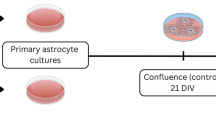Abstract
We report herein a study of aging using in vitro and in vivo models. Glial fibrillary acidic protein and ferritin expression levels increased, and the levels of glutamate transporter 1 and transferrin receptor 1 decreased in aging mouse spinal cord and its astrocytes. Mitochondrial transmembrane potential in astrocytes decreased after 60 d of culture. Given the relationship between aging and loss of antioxidant tolerance capacity, we examined the expression of heme oxygenase 1 (HO1) and NAD(P)H/quinone oxidoreductase 1 (NQO1) in the old mouse astrocytes and spinal cord. Indeed, both antioxidant enzymes decreased there. Total nuclear factor E2-related factor 2, which governs basal and inducible expression of HO1 and NQO1, decreased significantly. Significantly, epigallocatechin gallate restored the Nrf2 activity.










Similar content being viewed by others
References
Chan J. Y.; Kwong M. Impaired expression of glutathione synthetic enzyme genes in mice with targeted deletion of the Nrf2 basic-leucine zipper protein. Biochim. Biophys. Acta. 1517: 19–26; 2000.
Chen C.; Yu R.; Owuor E. D.; Kong A. N. Activation of antioxidant-response element (ARE), mitogen-activated protein kinases (MAPKs) and caspases by major green tea polyphenol components during cell survival and death. Arch. Pharm. Res. 23: 605–612; 2000. doi:10.1007/BF02975249.
Danbolt N. C. Glutamate uptake. Prog. Neurobiol. 65: 1–105; 2001. doi:10.1016/S0301-0082(00)00067-8.
Enomoto A.; Itoh K.; Nagayoshi E.; Haruta J.; Kimura T.; O’Connor T.; Harada T.; Yamamoto M. High sensitivity of Nrf2 knockout mice to acetaminophen hepatotoxicity associated with decreased expression of ARE-regulated drug metabolizing enzymes and antioxidant genes. Toxicol. Sci. 59: 169–177; 2001. doi:10.1093/toxsci/59.1.169.
Gottfried C.; Tramontina F.; Gonçalves D.; Gonçalves C. A.; Moriguchi E.; Dias R. D.; Wofchuk S. T.; Souza D. O. Glutamate uptake in cultured astrocytes depends on age: a study about the effect of guanosine and the sensitivity to oxidative stress induced by H(2)O(2). Mech. Ageing. Dev. 123: 1333–1340; 2002. doi:10.1016/S0047-6374(02)00069-6.
Haugeto O.; Ullensvang K.; Levy L. M.; Chaudhry F. A.; Honoré T.; Nielsen M.; Lehre K. P.; Danbolt N. C. Brain glutamate transporter proteins form homomultimers. J. Biol. Chem. 271: 27715–27722; 1996. doi:10.1074/jbc.271.44.27715.
Hentze M. W.; Muckenthaler M. U.; Andrews N. C. Balancing acts: molecular control of mammalian iron metabolism. Cell. 117: 285–297; 2004. doi:10.1016/S0092-8674(04)00343-5.
Kane C. J.; Sims T. J.; Gilmore S. A. Astrocytes in the aged rat spinal cord fail to increase GFAP mRNA following sciatic nerve axotomy. Brain Res. 759: 163–165; 1997. doi:10.1016/S0006-8993(97)00359-4.
Klamt F.; Gottfried C.; Tramontina F.; Dal-Pizzol F.; Da Frota M. L. Jr; Moreira J. C.; Dias R. D.; Moriguchi E.; Wofchuk S.; Souza D. O. Time-related increase in mitochondrial superoxide production, biomolecule damage and antioxidant enzyme activities in cortical astrocyte cultures. Neuroreport. 13: 1515–1518; 2002. doi:10.1097/00001756-200208270-00005.
Li C. Y.; Liu X. Y.; Bu H.; Li Z.; Li B.; Sun M. M.; Guo Y. S.; Liu Y. L.; Zhang Y. Prevention of glutamate excitotoxicity in motor neurons by 5,6-dihydrocyclopenta-1,2-dithiole-3-thione: implication to the development of neuroprotective drugs. Cell. Mol. Life. Sci. 64: 1861–1869; 2007. doi:10.1007/s00018-007-7189-5.
Lin D. T.; Wu J.; Holstein D.; Upadhyay G.; Rourk W.; Muller E.; Lechleiter J. D. Ca2+ signaling, mitochondria and sensitivity to oxidative stress in aging astrocytes. Neurobiol. Aging. 28: 99–111; 2006. doi:10.1016/j.neurobiolaging.2005.11.004.
Lin M. T.; Beal M. F. Mitochondrial dysfunction and oxidative stress in neurodegenerative diseases. Nature. 433: 787–795; 2006. doi:10.1038/nature05292.
Lu J.; Sun W.; Chen D. Y. Preparation of immunofluorescence double staining sample for laser confocal microscope. Immunol. Methods. 23: 344–346; 2007.
Mandel S.; Amit T.; Reznichenko L.; Weinreb O.; Youdim M. B. Green tea catechins as brain-permeable, natural iron chelators-antioxidants for the treatment of neurodegenerative disorders. Mol. Nutr. Food Res. 50: 229–234; 2006. doi:10.1002/mnfr.200500156.
Nagai M.; Re D. B.; Nagata T.; Chalazonitis A.; Jessell T. M.; Wichterle H.; Przedborski S. Astrocytes expressing ALS-linked mutated SOD1 release factors selectively toxic to motor neurons. Nat. Neurosci. 10: 615–622; 2007. doi:10.1038/nn1876.
Otis T. S.; Kavanaugh M. P. Isolation of current components and partial reaction cycles in the glial glutamate transporter EAAT2. J. Neurosci. 20: 2749–2757; 2000.
Pantopoulos K.; Hentze M. W. Rapid responses to oxidative stress mediated by iron regulatory protein. EMBO J. 14: 2917–2924; 1995.
Papadopoulos M. C.; Koumenis I. L.; Yuan T. Y.; Giffard R. G. Increasing vulnerability of astrocytes to oxidative injury with age despite constant antioxidant defenses. Neuroscience. 82: 915–925; 1998. doi:10.1016/S0306-4522(97)00320-5.
Pertusa M.; Garcia-Matas S.; Rodriguez-Farre E.; Sanfeliu C.; Cristofol R. Astrocytes aged in vitro show a decreased neuroprotective capacity. J. Neurochem. 101: 794–805; 2007. doi:10.1111/j.1471-4159.2006.04369.x.
Rothstein J. D.; Dykes-Hoberg M.; Pardo C. A.; Bristol L. A.; Jin L.; Kuncl R. W.; Kanai Y.; Hediger M. A.; Wang Y.; Schielke J. P.; Welty D. F. Knockout of glutamate transporters reveals a major role for astroglial transport in excitotoxicity and clearance of glutamate. Neuron. 16: 675–686; 1996. doi:10.1016/S0896-6273(00)80086-0.
Silva G. A.; Feeney C.; Mills L. R.; Theriault E. Novel and rapid method for culturing pure rat spinal cord astrocytes on untreated glass. J. Neurosci. Methods 80: 75–79; 1998. doi:10.1016/S0165-0270(97)00198-2.
Zhang Y.; Gordon G. B. A strategy for cancer prevention: stimulation of the Nrf2-ARE signaling pathway. Mol. Cancer Ther. 3: 885–893; 2004.
Author information
Authors and Affiliations
Corresponding author
Additional information
Editor: J. Denry Sato
Weisong Duan and Ruiyan Zhang contributed equally to the work.
Rights and permissions
About this article
Cite this article
Duan, W., Zhang, R., Guo, Y. et al. Nrf2 activity is lost in the spinal cord and its astrocytes of aged mice. In Vitro Cell.Dev.Biol.-Animal 45, 388–397 (2009). https://doi.org/10.1007/s11626-009-9194-5
Received:
Accepted:
Published:
Issue Date:
DOI: https://doi.org/10.1007/s11626-009-9194-5




